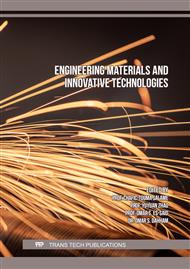[1]
M. B. Uday, M. N. Ahmad Fauzi, H. Zuhailawati, and A. B. Ismail, (2010), Advances in friction welding process: a review, Science and Technology of Welding and Joining, vol. 15 (7), p.534–558.
DOI: 10.1179/136217110x12785889550064
Google Scholar
[2]
M. Avinash, G. V. K. Chaitanya, D. K. Giri, S. Upadhya, and B. K. Muralidhara, (2007), Microstructure and mechanical behaviuor of rotary friction welded titanium alloys, International Journal of Materials and Metallurgical Engineering, vol. 1 (11), p.641–643.
Google Scholar
[3]
Wang, G.L., Li, J.L., Wang, W.L. et al., (2018), Rotary friction welding on dissimilar metals of aluminum and brass by using pre-heating method. Int J Adv Manuf Technol, vol. 99, p.1293–1300.
DOI: 10.1007/s00170-018-2572-y
Google Scholar
[4]
Alves, Eder & Toledo, Rafael & Botter, Fabio & An, Chen. (2019). Experimental Thermal Analysis in Rotary Friction Welding of Dissimilar Materials. Journal of Aerospace Technology and Management. vol. 11. e4019.
DOI: 10.5028/jatm.v11.1068
Google Scholar
[5]
Nu, Ho & Le, Truyen & Minh, Luu & Nguyen, Huu Loc. (2019). A Study on Rotary Friction Welding of Titanium Alloy (Ti6Al4V). Advances in Materials Science and Engineering. vol. 2019, pp.1-9.
DOI: 10.1155/2019/4728213
Google Scholar
[6]
Shanjeevi C, Satish Kumar S and Sathiya P., (2016), Multi-objective optimization of friction welding parameters in AISI 304L austenitic stainless steel and copper joints. Proc IMechE, Part B: J Engineering Manufacture; vol. 230, p.449–457.
DOI: 10.1177/0954405414555590
Google Scholar
[7]
Víctor Alcántara Alza, (2020). Mechanical Properties and Microstructure, in welded joints of Low and Medium Carbon Steels, Applying Rotary Friction. International Journal of Recent Technology and Engineering (IJRTE) ISSN: 2277-3878, vol 8(6), pp.5176-5185.
DOI: 10.35940/ijrte.f9522.038620
Google Scholar
[8]
G. Chen, C. Ren, X. Qin, and J. Li, (2015), Temperature dependent work hardening in Ti-6Al-4V alloy over large temperature and strain rate ranges: experiments and constitutive modeling, Materials & Design, vol. 83, p.598–610.
DOI: 10.1016/j.matdes.2015.06.048
Google Scholar
[9]
Rosa, Avital & Moreto, J. & Manfrinato, Marcos & Rossino, Luciana. (2014), Study on Friction and Wear Behavior of SAE 1045 steel, reinforced Nylon 6.6 and NBR Rubber Used in Clutch Disks. Materials Research, vol 17, pp.1397-1403.
DOI: 10.1590/1516-1439.282714
Google Scholar



